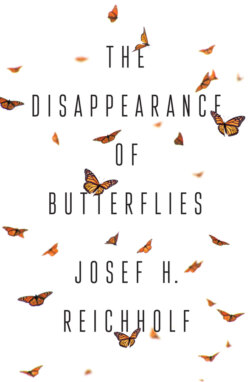Читать книгу The Disappearance of Butterflies - Josef H. Reichholf - Страница 14
Evenings at the pond
ОглавлениеAs the sun went down, the croaking of the pool frogs rose to a final climax in polyphonic harmony, the noise feathering the surface of the gravel pit pond. Now it was the tree frogs’ turn to start their part. But only one managed a short ‘ep, ep, ep’ and then went quiet. It was, after all, already too late in the year for the tree frogs. They give their concerts in April or at the start of May. Now rats investigated the rubbish heaps on the bank. Dark silhouettes, they scurried over rubble and household rubbish, looking for anything edible. For a few moments they distracted me from observing the aquatic moths. Looking through my low-light binoculars, I saw that there were brown rats of all sizes. There were some true giants, or so it seemed to me, that would have made deadly foes for cats. But there were also small ones that hunted around with their mothers and never strayed from their sides. As a trembling shadow flitted across the binoculars’ field of vision, I noticed that there were also bats swirling around me. They were catching water insects over the pond. Twilight is the flight time for caddis flies and mayflies. As I pointed the focused beam of my torch this way and that they rose into the air in every direction. Late dusk turned to darkness. I had taken the torch with me in order to see for how long the aquatic moths flew. It seemed that they did not fly late into the night: in the last rays of daylight I recognized considerably fewer of them over the water surface.
The moths withdrew to the banks. From their short hovering flights, they landed on the stalks of plants and kept quiet. Perhaps it had become too cool for them, I thought, and felt for myself the moist, fresh chill of the early summer night. Based on these first impressions, I would have to measure the decrease in brightness and temperature. For the decrease in brightness, the light meter I still used to adjust the aperture of my camera in the 1960s ought to suffice. Measuring the air temperature would not be so easy, as I soon found out through attempts with a laboratory thermometer, since it showed very different temperatures depending on its proximity to the water surface, the reeds and the distance that I held it from my body. In field work half a century ago, we were a long way off today’s precise temperature measurements. The counting of the flying moths was also rather problematic, to put it mildly. They swarmed so erratically over the water surface and along the edges of the reedbeds. In the dwindling evening light, they would gradually become more and more numerous, and then suddenly peter out. Counting attempts carried out rapidly one after another gave embarrassingly different figures. My conviction that I would be able to obtain an interesting doctoral thesis about these delightful moths using these methods gave way, over the next few evenings that I spent at the pond, to nascent anxiety as to whether I would be able to obtain findings that would be reliable and novel enough. Without doubt, it would still be necessary to keep the caterpillars in aquariums, together with the water plants they ate. The enclosures for the adult butterflies would have to be improved and redesigned so that they were closer to natural conditions. Obviously, conditions for making observations outside by the pond would not be ideal every evening.
It soon became apparent that, despite the convenience of having ponds with the aquatic moths almost by my front door, field research would have to contend with the weather and with unpredictable events. For example, a few weeks after the beginning of my investigations, one of the gravel pits was converted into a carp pond. Consequently, all the water plants there were immediately destroyed. At least back then, few of the fertilizers and poisons used in agriculture found their way into the gravel pits or the oxbow lakes in the riparian forest. I never suspected that a mere decade after the conclusion of my investigations, the pits would all be destroyed. They were filled in, levelled and planted with trees or turned back into arable land. Of all people, it was the nature conservationists who did this, declaring them to be ‘wounds in the landscape’ that had to be closed. New wounds of this kind would not be permitted, allowing the landscape to remain ‘intact’. I still feel a pang whenever I go past the places where I carried out the field research for my doctorate. Some are covered by maize fields, while on one of them trees have grown and formed a small copse. They have all been filled in. Small losses such as these begin to erode one’s sense of home. But back to the lifecycle of the brown china-mark. By continuing, I hope to show why these little beings fascinated me so much that they would affect me for the rest of my life as a zoologist, and why they became icons for me, for Lepidoptera in general.
